Overview
The article underscores the critical need for effective construction air quality safety programs to achieve compliance with regulatory standards. Adherence to guidelines established by agencies such as the EPA and the Clean Air Act is essential for safeguarding public health and improving safety on construction sites. This necessity is illustrated through various case studies and best practices detailed throughout the content.
Introduction
In the realm of energy and infrastructure development, the significance of air quality management is paramount. Organizations face the dual challenge of meeting regulatory requirements while promoting sustainable practices. Understanding the interplay between construction activities and air quality standards is essential. This article explores multifaceted approaches to maintaining air quality, examining key regulations, guidelines, and best practices. Such insights empower construction managers to safeguard public health and enhance project outcomes.
From the Clean Air Act to innovative training programs, the information presented here underscores the critical role of compliance in fostering a healthier environment and advancing the transition to cleaner energy solutions.
Harbinger Land | Comprehensive Solutions for Land Services in Energy and Infrastructure
Harbinger Land stands at the forefront of tailored land services for energy and infrastructure projects. We specialize in site and right-of-way acquisition, title research, GIS mapping, and advanced data processing solutions. Our expert team negotiates and secures the essential leases and easements for distributed energy resources (DER) and infrastructure development. By leveraging highly integrated GIS modeling services, we facilitate efficient easements, ultimately saving our clients both time and money.
Utilizing cutting-edge technology, including AI-powered title research software and efficient document imaging solutions, we significantly enhance operational efficiency and elevate client satisfaction. Our knowledgeable team adeptly navigates the complex legal and regulatory landscape, establishing us as a crucial partner in implementing effective construction air quality safety programs. This commitment to compliance not only meets regulatory standards but also supports the broader transition to sustainable energy solutions.
Consider successful case studies like Texas, which leads the U.S. in wind power generation. Favorable policies and abundant land have attracted substantial renewable energy investments, underscoring the essential role of comprehensive land services in fostering a greener future. Furthermore, with the EU's 'Fit for 55' package and REPowerEU plan prompting necessary legislative changes, the significance of energy-efficient technologies as critical allies in curbing demand for power across various sectors cannot be overstated.
Are you ready to partner with us in navigating these challenges? Let Harbinger Land guide you through the complexities of land acquisition and help you achieve your energy goals.
Clean Air Act | Key Regulations for Construction Air Quality Management
The Clean Air Act (CAA) serves as a pivotal federal law that governs air emissions from both stationary and mobile sources. It establishes National Ambient Air Quality Standards (NAAQS) for six prevalent air pollutants, such as particulate matter and ozone. For example, the primary standard for sulfur dioxide is set at 0.5 ppm over a 3-hour averaging time.
Compliance with these standards is essential for construction projects that prioritize construction air quality safety programs to mitigate air pollution and protect public health. Understanding the CAA is vital for site managers striving to develop construction air quality safety programs that comply with federal regulations.
Recent case studies, including Environment Texas and Sierra Club v. Valero Port Arthur Refinery, highlight the critical impact of adherence on air management within construction projects, underscoring the necessity of addressing industrial pollution.
Furthermore, Kathy Calvin, President & CEO of the United Nations Foundation, cautions that the repercussions of neglecting climate change are profound, encompassing environmental degradation and health risks. This underscores the importance of construction air quality safety programs in the building sector, which not only safeguards community health but also presents economic opportunities in the transition to a low-carbon future.
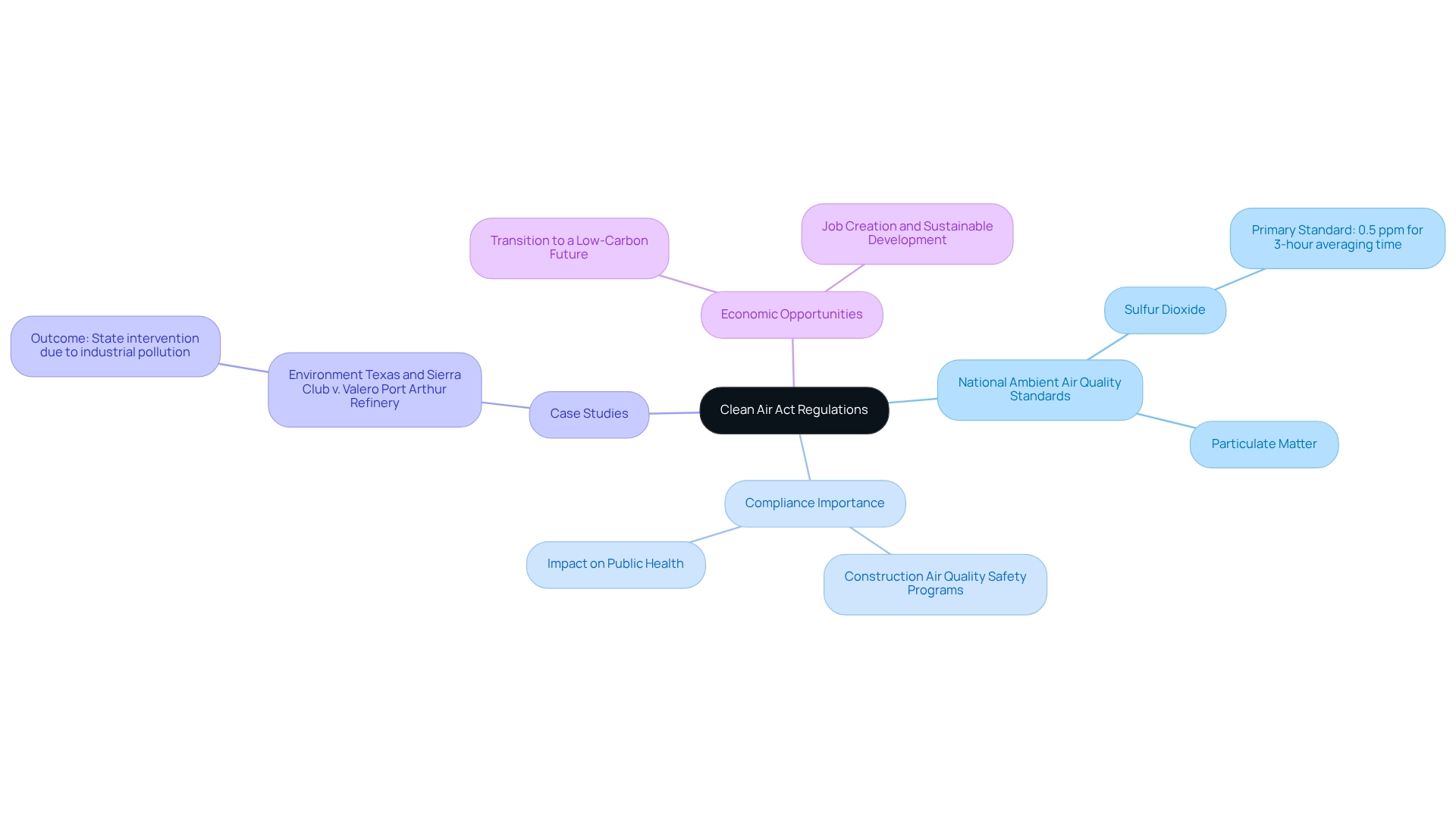
EPA Air Quality Guidelines | Essential Resources for Construction Projects
The Environmental Protection Agency (EPA) plays a crucial role in establishing air standards that serve as essential resources for building projects. These guidelines encompass best practices for dust control, emissions monitoring, and compliance strategies. By leveraging these resources, project managers can develop robust construction air quality safety programs, which ensure regulatory compliance and minimize environmental impact. Notably, recent research indicates that effective dust management strategies can reduce airborne particulate matter by up to 50%, significantly improving air quality around construction sites.
A pivotal case study highlights the EPA's commitment to public engagement in revising air standards, evidenced by over 700,000 written comments received, which underscores the agency's dedication to transparency and stakeholder involvement. As Dr. Doris Browne, former president of the National Medical Association, articulated, 'As a physician and an advocate for clean air, our ultimate goal is health equity.'
By utilizing these resources, building teams can establish construction air quality safety programs that are comprehensive and align with the latest EPA guidelines, ensuring both compliance and the health of the community.

Colorado Department of Public Health and Environment | Air Quality Modeling Guidance for Permits
The Colorado Department of Public Health and Environment provides essential air condition modeling guidance, a critical component for securing permits in construction projects. This guidance outlines the necessary modeling methods to assess potential air condition effects, ensuring compliance with state regulations. Notably, for General Permit applications, obtaining a Modeling Review Report is mandatory before submission, underscoring the significance of adherence in the permitting process. Construction managers must familiarize themselves with these requirements to effectively navigate the permitting landscape and implement necessary construction air quality safety programs.
Recent statistics reveal that compliance with air standards markedly enhances permit approval rates, especially in Colorado, where following these guidelines is vital for project success. Furthermore, updates slated for 2025 stress the integration of advanced modeling techniques to improve environmental assessments. Engaging with environmental scientists highlights a consensus on the necessity of thorough air evaluations within construction air quality safety programs, reinforcing the idea that proactive measures are essential for safeguarding public health and the environment. As Richard Rogers aptly stated, 'The only path ahead, if we are to enhance the condition of the environment, is to engage everyone.' This perspective aligns with the Harbinger Land case study, demonstrating how effective air assessment modeling and strict adherence can lead to improved project outcomes.

EPA Building Air Quality Guide | Best Practices for Facility Managers
The EPA's Building Air Quality Guide is a vital resource for facility managers who are implementing construction air quality safety programs to uphold healthy indoor environments. It outlines best practices such as:
- Regular ventilation system maintenance
- Monitoring indoor air pollutants
- Implementing source control measures
Furthermore, the EPA provides essential guidance on the necessity of air duct cleaning and criteria for selecting a duct cleaner, equipping facility managers with actionable insights for effective maintenance practices. By adhering to these guidelines, facility managers can significantly enhance indoor air standards through construction air quality safety programs, ensuring compliance with air regulations and bolstering the health and safety of building occupants.
Moreover, the U.S. Green Building Council’s Center for Green Schools has secured $6.5 million to develop strategies for indoor air management and greenhouse gas reduction, underscoring the growing emphasis on construction air quality safety programs. In addition, the National Institute for Occupational Safety and Health (NIOSH) extends its support by offering health hazard assessments for offices suspected of indoor air issues, which aligns with the construction air quality safety programs, providing an additional layer of assistance for facility managers.
Successful case studies, such as the data-driven approach at MSI Express, illustrate how data sharing can enhance operational efficiency and facilitate compliance with air quality standards. By implementing these best practices, facility managers can cultivate healthier workspaces that yield benefits for both employees and the organization.
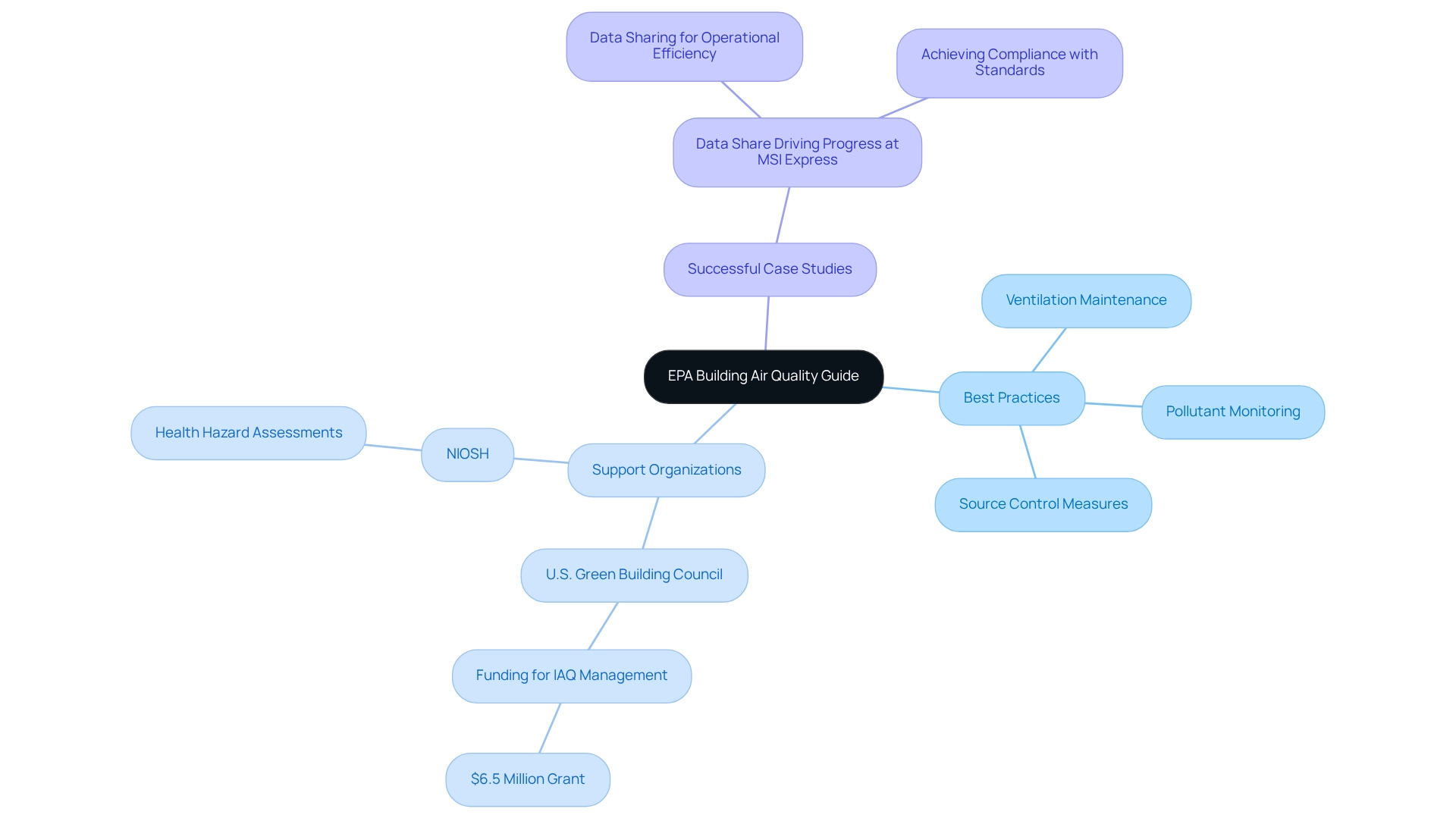
Iowa Department of Education | Air Quality Maintenance Resources for School Facilities
The Iowa Department of Education provides critical resources for maintaining air quality standards in school facilities, focusing on ventilation guidelines, pollutant source identification, and preventive maintenance strategies. These guidelines are vital for ensuring compliance with current air standards, which are increasingly recognized for their impact on student health and learning outcomes. For instance, the use of MERV 13 rated filters can capture 93% of microscopic airborne particles, significantly improving indoor air quality without sacrificing airflow. By implementing these recommendations, school administrators can create healthier learning environments, ultimately boosting student well-being and academic performance.
Furthermore, expert opinions emphasize that effective air management is essential in educational settings, as it directly influences cognitive function and overall health. Successful application of these air standards has been observed in various educational institutions, underscoring the importance of proactive measures in fostering safe and conducive learning environments. Additionally, understanding and reducing volatile organic compounds (VOCs) is crucial for enhancing indoor air quality, as these substances can negatively impact health. Richard Rogers wisely stated, 'The only path ahead, if we are going to enhance the state of the environment, is to engage everyone.' This collaborative approach is fundamental for upholding air quality standards in educational environments.
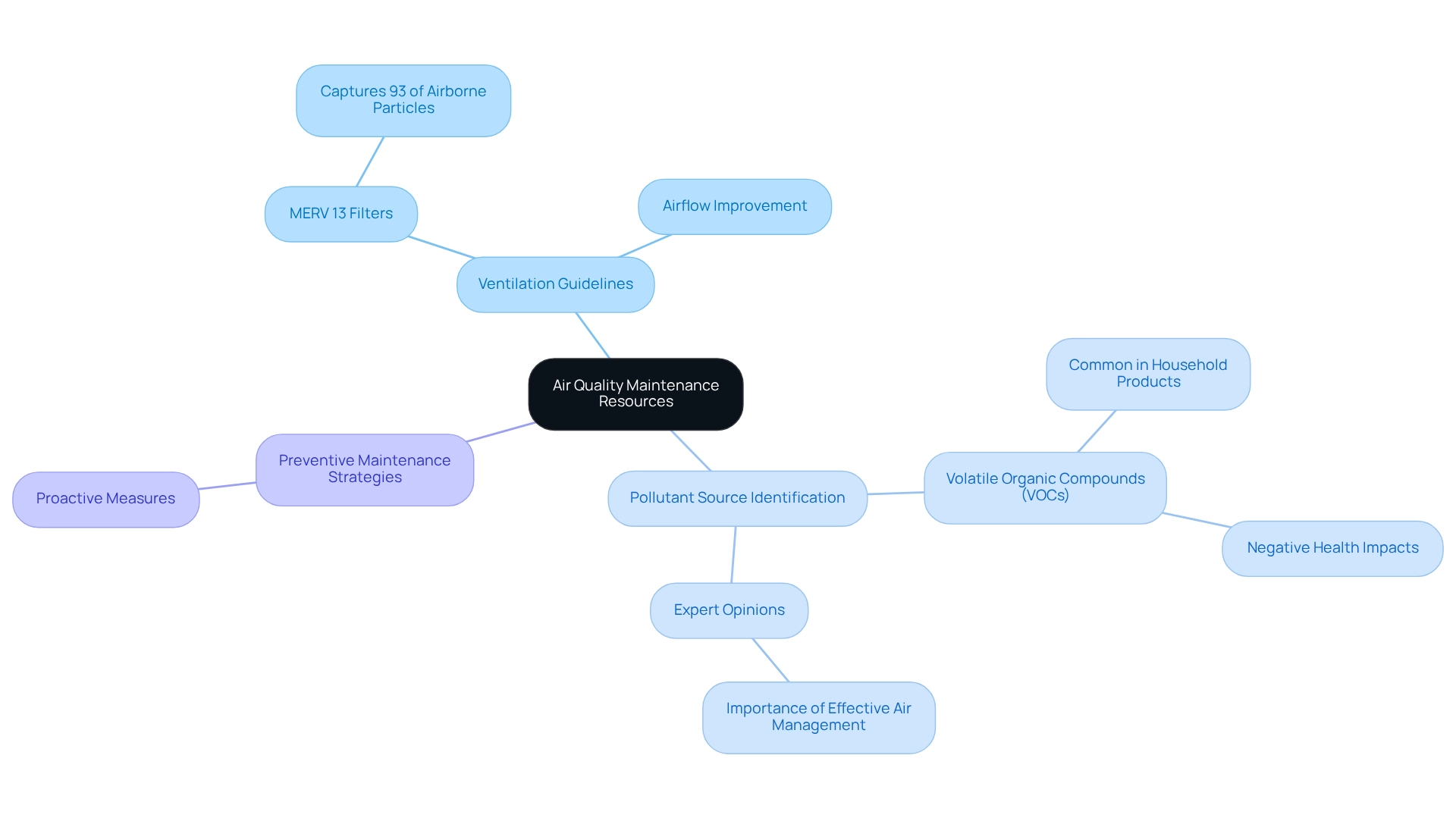
Illinois Department of Transportation | Air Quality Standards for Transportation Projects
The Illinois Department of Transportation (IDOT) establishes crucial air standards that transportation projects must adhere to in order to mitigate emissions and protect public health. These standards are designed to prevent any further deterioration of air quality. Transportation planners and engineers are required to integrate these standards into their project designs and operations, thereby ensuring compliance and fostering sustainable transportation solutions.
As we approach 2025, adherence to these standards is increasingly critical, reflecting the most recent advancements in emissions reduction strategies. Successful transportation initiatives in Illinois have demonstrated effective compliance with these regulations, showcasing innovative methods of incorporating air standards into project designs. Recent initiatives have highlighted the importance of fog analysis in identifying and prioritizing leakage zones, significantly enhancing compliance efforts and underscoring its role in emission reduction strategies.
A prime example is the retrofitting of existing buses to meet new cold-weather standards. This initiative involved rigorous testing and assurance processes that resulted in improved thermal performance and reduced emissions. Notably, statistics reveal that the research and development phases of the grant for the advanced fleet of buses designed for cold-weather environments were completed by spring of 1998, illustrating the timeline and commitment to achieving air standards. Concurrently, several diagnostic tests conducted on electric buses have enhanced data accuracy regarding thermal envelopes, further emphasizing the technological advancements being embraced in transportation projects to align with air standards. Environmental planners underscore the necessity of incorporating construction air quality safety programs during the planning stages, ensuring that projects not only comply with regulations but also foster healthier communities. As the transportation landscape evolves, continuous collaboration between state transportation departments and project planners will be vital in achieving sustainable outcomes. The Chittendon County Transit Authority (CCTA) has reported no complaints concerning the heating or defrosting systems in their electric buses, exemplifying successful adherence to air standards and the effectiveness of these initiatives.

Philadelphia Air and Noise Pollution Reporting | Tools for Construction Safety
Philadelphia offers essential resources for documenting air and noise pollution, which are vital for ensuring safety in building projects and compliance with regulations. These mechanisms empower residents and workers to report violations, thereby guaranteeing that construction activities adhere to construction air quality safety programs.
By 2025, compliance rates for building activities in urban areas have demonstrated notable improvement, thanks in part to effective reporting tools that facilitate this progress. Construction managers are urged to utilize these resources to monitor adherence to construction air quality safety programs and swiftly address any violations.
This proactive approach not only enhances workplace safety but also fosters community engagement in air quality issues, ultimately leading to a healthier environment for all.

Texas A&M Engineering Extension Service | Environmental Health and Safety Training
The Texas A&M Engineering Extension Service offers critical environmental health and safety training programs tailored for laborers in the building sector. These comprehensive construction air quality safety programs address air standards regulations, pollutant control measures, and best practices for fostering a safe work environment.
Participation in these training sessions significantly enhances industry professionals' understanding of air quality regulations, equipping them with the skills to implement effective construction air quality safety programs on-site. Training programs have notably resulted in improved compliance rates, with statistics showing that each avoided fatality saves approximately $1,390,000.
Furthermore, successful case studies indicate that organizations prioritizing such training not only fulfill regulatory requirements but also nurture a safety-first culture, ensuring that every worker returns home safely. The building sector faces substantial safety challenges, including nonfatal transportation incidents, underscoring the urgent need for thorough training.
OSHA penalties for safety violations can be considerable, highlighting the financial risks associated with neglecting safety protocols. As Luis Batongbakal states, "Prompt hazard reporting enables managers to document incidents and implement preventive measures accordingly."
As the building sector evolves, the emphasis on construction air quality safety programs and air standards regulations training remains crucial for safeguarding public safety and ecological health.
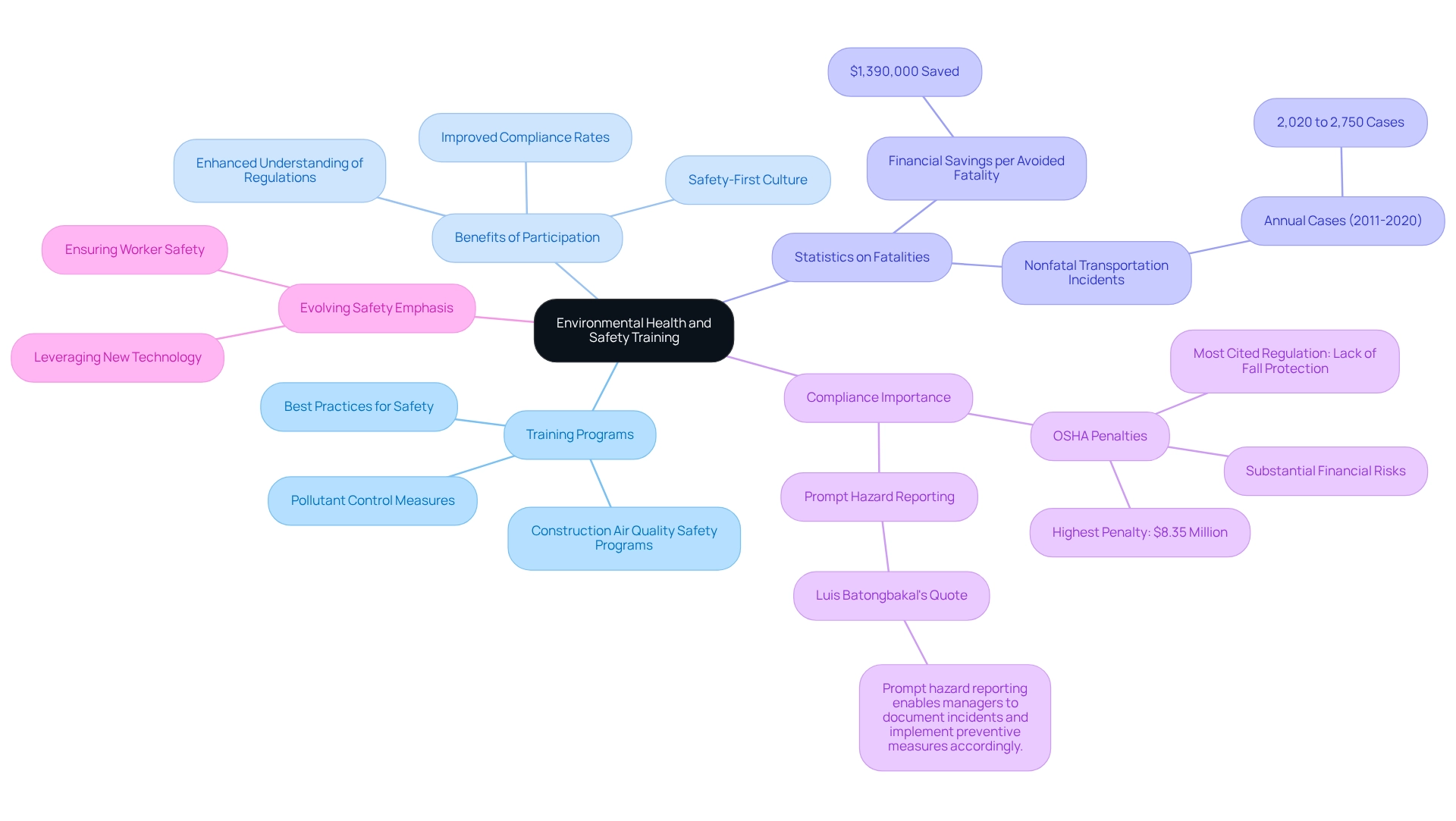
NIOSH Air Quality Safety Guidelines | Research and Recommendations for Construction
The National Institute for Occupational Safety and Health (NIOSH) establishes air safety guidelines grounded in extensive research, aimed at minimizing exposure to airborne contaminants during construction activities. These guidelines are crucial for project managers dedicated to protecting worker health and ensuring compliance with construction air quality safety programs. Notably, the 2025 updates underscore the importance of implementing effective airborne dust mitigation plans as part of construction air quality safety programs, particularly for projects exceeding one acre, which must be submitted to the Bay Area Air Quality Management District (BAAQMD) before commencement. Furthermore, these updates introduce enhanced monitoring protocols and stricter compliance measures within the construction air quality safety programs to guarantee adherence to air standards throughout the duration of building projects.
To effectively reduce airborne contaminants, NIOSH recommends several best practices, including:
- The suspension of excavation and grading activities when wind speeds exceed 25 mph. This precaution is vital in curbing the spread of dust and other particulates that can compromise air quality.
- Ensuring that Automated External Defibrillators (AEDs) and trained personnel in CPR are readily accessible, as research reveals that sudden cardiac arrest can occur unexpectedly on job sites.
By integrating these safety protocols, companies not only protect employees' well-being but also cultivate a more secure workplace overall.
Case studies illustrate that construction firms employing state-of-the-art technologies, such as real-time air monitoring systems and advanced dust control methods, significantly elevate safety standards and mitigate hazards. By staying informed about the latest NIOSH air safety guidelines and implementing effective control measures, businesses can improve their construction air quality safety programs, thereby fostering safer work environments and preventing injuries and fatalities.
As Deputy Secretary of Labor Keith Sonderling emphasizes, prioritizing construction air quality safety programs is essential for the health of all workers on construction sites. Occupational health experts advocate for continuous education and training on these guidelines to ensure that all personnel are equipped to manage air quality effectively as part of construction air quality safety programs during building projects. By actively engaging with these recommendations, construction managers can cultivate a culture of safety and compliance that benefits both workers and the project as a whole.
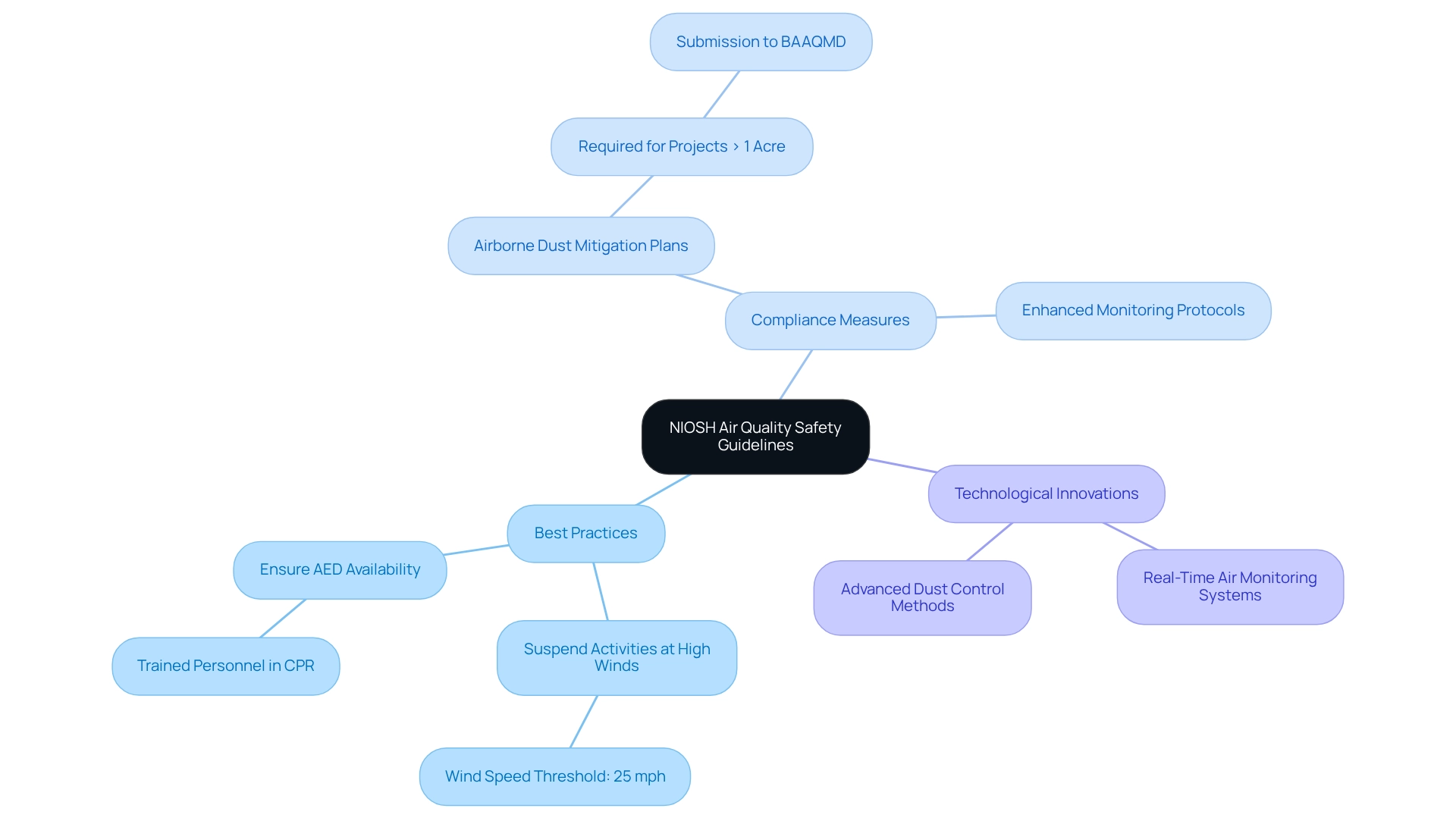
Conclusion
Maintaining air quality in construction and infrastructure development is not merely a regulatory obligation; it is a crucial commitment to safeguarding public health and promoting sustainable practices. Understanding key regulations, such as the Clean Air Act and various EPA guidelines, provides essential frameworks for construction managers to follow. By implementing effective air quality safety programs and utilizing innovative technologies, organizations can significantly reduce emissions and enhance project outcomes.
Furthermore, integrating comprehensive training programs and resources from state departments ensures that construction teams are well-equipped to manage air quality challenges. Successful case studies from Texas and Illinois demonstrate that adherence to air quality standards fosters a healthier environment and drives economic opportunities in the transition to cleaner energy solutions. The collaborative efforts of various stakeholders, including regulatory agencies and construction firms, are vital in creating safer and more sustainable work environments.
As the landscape of energy and infrastructure evolves, prioritizing air quality management remains key to achieving long-term sustainability goals. By embracing best practices and engaging in proactive compliance, the construction industry can significantly contribute to a greener future while protecting the health of communities and workers alike. The time for action is now; effective air quality management is a commitment to fostering a healthier planet for generations to come.
Frequently Asked Questions
What services does Harbinger Land provide?
Harbinger Land specializes in tailored land services for energy and infrastructure projects, including site and right-of-way acquisition, title research, GIS mapping, and advanced data processing solutions.
How does Harbinger Land assist with energy and infrastructure projects?
The expert team at Harbinger Land negotiates and secures essential leases and easements for distributed energy resources (DER) and infrastructure development, leveraging integrated GIS modeling services to enhance efficiency and save clients time and money.
What technologies does Harbinger Land use to improve operational efficiency?
Harbinger Land utilizes cutting-edge technology such as AI-powered title research software and efficient document imaging solutions to significantly enhance operational efficiency and elevate client satisfaction.
How does Harbinger Land ensure compliance with legal and regulatory standards?
The knowledgeable team at Harbinger Land navigates the complex legal and regulatory landscape, ensuring compliance with regulations and supporting the implementation of effective construction air quality safety programs.
What is the significance of the Clean Air Act (CAA) in construction projects?
The Clean Air Act governs air emissions and establishes National Ambient Air Quality Standards (NAAQS) for pollutants. Compliance with these standards is essential for construction projects that prioritize air quality safety and public health.
Why are construction air quality safety programs important?
These programs help mitigate air pollution, protect public health, and ensure compliance with federal regulations, which is vital for site managers in the construction sector.
What role does the Environmental Protection Agency (EPA) play in air quality management for construction?
The EPA establishes air standards and guidelines that serve as essential resources for building projects, including best practices for dust control and emissions monitoring, helping project managers develop robust air quality safety programs.
How can effective dust management strategies impact air quality on construction sites?
Recent research indicates that effective dust management strategies can reduce airborne particulate matter by up to 50%, significantly improving air quality around construction sites.
What is the broader impact of neglecting climate change in relation to construction air quality?
Neglecting climate change can lead to environmental degradation and health risks, emphasizing the importance of construction air quality safety programs in safeguarding community health and presenting economic opportunities in the transition to a low-carbon future.
List of Sources
- Harbinger Land | Comprehensive Solutions for Land Services in Energy and Infrastructure
- Optimizing Energy Projects: Land Acquisition and Consulting for Sustainable Development (https://blog.harbingerland.com/optimizing-energy-projects-land-acquisition-and-consulting-for-sustainable-development)
- How Much Land Is Needed for 100% Renewable Energy? (Latest Research Stats) (https://patentpc.com/blog/how-much-land-is-needed-for-100-renewable-energy-latest-research-stats)
- TOP 25 AIR QUALITY QUOTES | A-Z Quotes (https://azquotes.com/quotes/topics/air-quality.html)
- Clean Air Act | Key Regulations for Construction Air Quality Management
- National Ambient Air Quality Standards, 2001-2016 (https://ballotpedia.org/National_Ambient_Air_Quality_Standards,_2001-2016)
- 7 Quotes on Climate Change and Health | unfoundation.org (https://unfoundation.org/blog/post/7-quotes-on-climate-change-and-health)
- Clean Air Archives - National Environmental Law Center (https://nelc.org/issues/clean-air)
- EPA Air Quality Guidelines | Essential Resources for Construction Projects
- National Ambient Air Quality Standards (NAAQS) for Particulate Matter (PM) – Environmental and Energy Law Program (https://eelp.law.harvard.edu/tracker/epa-finalized-stricter-national-ambient-air-quality-standards-naaqs-for-particulate-matter-pm)
- DEEP DIVE: U.S. EPA Finalizes Ambient Air Quality Standards for Particulate Matter | 3E (https://3eco.com/article/deep-dive-u-s-epa-finalizes-ambient-air-quality-standards-for-particulate-matter)
- EPA Welcomes Input on Technical Documents for Cleaner Construction Materials and Shares Action Plans for 2025 | US EPA (https://epa.gov/chemicals-under-tsca/epa-welcomes-input-technical-documents-cleaner-construction-materials-and)
- Colorado Department of Public Health and Environment | Air Quality Modeling Guidance for Permits
- Air quality modeling guidance for permits | Colorado Department of Public Health and Environment (https://cdphe.colorado.gov/emissions-from-business-and-industry/air-quality-modeling-guidance-for-permits)
- 15 Inspirational Quotes On The Environment | EcoMENA (https://ecomena.org/inspirational-quotes-environment)
- Quotations about the Environment | US EPA (https://epa.gov/history/quotations-about-environment)
- 30 of the Most Impactful Climate Change Quotes - Curious Earth (https://curious.earth/blog/climate-change-quotes)
- EPA Building Air Quality Guide | Best Practices for Facility Managers
- The Inside Story: A Guide to Indoor Air Quality | US EPA (https://epa.gov/indoor-air-quality-iaq/inside-story-guide-indoor-air-quality)
- EPA Funds $34M to Improve Indoor Air Quality at Schools - Facilities Management Advisor (https://facilitiesmanagementadvisor.blr.com/heating-and-cooling/epa-funds-34m-to-improve-indoor-air-quality-at-schools)
- brightlysoftware.com (https://brightlysoftware.com/blog/5-quotes-better-facility-maintenance)
- Iowa Department of Education | Air Quality Maintenance Resources for School Facilities
- Why School Indoor Air Quality Matters - IAQ.Works (https://iaq.works/indoor-air/how-school-building-conditions-and-indoor-air-quality-impacts-education)
- 15 Inspirational Quotes On The Environment | EcoMENA (https://ecomena.org/inspirational-quotes-environment)
- Illinois Department of Transportation | Air Quality Standards for Transportation Projects
- FOAM-TECH: Case Studies - Electric Bus Project (https://foam-tech.com/case_studies/electric_bus.htm)
- Philadelphia Air and Noise Pollution Reporting | Tools for Construction Safety
- Air Sensor Loan Programs | US EPA (https://epa.gov/air-sensor-toolbox/air-sensor-loan-programs)
- Issue 20: Struggling to breathe: How a health department is working with community members to reduce air pollution and improve health equity in Oakland - Berkeley Media Studies Group (https://bmsg.org/resources/publications/issue-20-struggling-to-breathe-how-a-health-department-is-working-with-community-members-to-reduce-air-pollution-and-improve-health-equity-in-oakland)
- ABCST is delivering more construction safety training with Arlo (https://arlo.co/case_studies/abcst-is-delivering-more-construction-safety-training-with-arlo)
- Texas A&M Engineering Extension Service | Environmental Health and Safety Training
- 72 Construction Safety Statistics for 2025 (https://workyard.com/construction-management/construction-safety-statistics)
- Construction Industry Safety Statistics: Key Facts (https://rcademy.com/construction-industry-safety-statistics)
- NIOSH Air Quality Safety Guidelines | Research and Recommendations for Construction
- Toxic Air Contaminants (TAC) | Environment, Health & Safety (https://ehs.ucsf.edu/environment/toxic-air-contaminants-tac)
- Construction Safety in 2025: Trends, Statistics & Best Practices (https://ishn.com/articles/114721-construction-safety-in-2025-trends-statistics-and-best-practices)
- Construction Safety Week 2025 Rallies Industry Around Shared Responsibility and Safer Jobsites -- Occupational Health & Safety (https://ohsonline.com/articles/2025/05/05/construction-safety-week-2025-rallies-industry-around-shared-responsibility-and-safer-jobsites.aspx?admgarea=ht.Hazmat&jw_start=)
- Department of Labor to highlight safe construction work practices during 2025 National Safety Stand-Down to Prevent Falls (https://dol.gov/newsroom/releases/osha/osha20250506)




